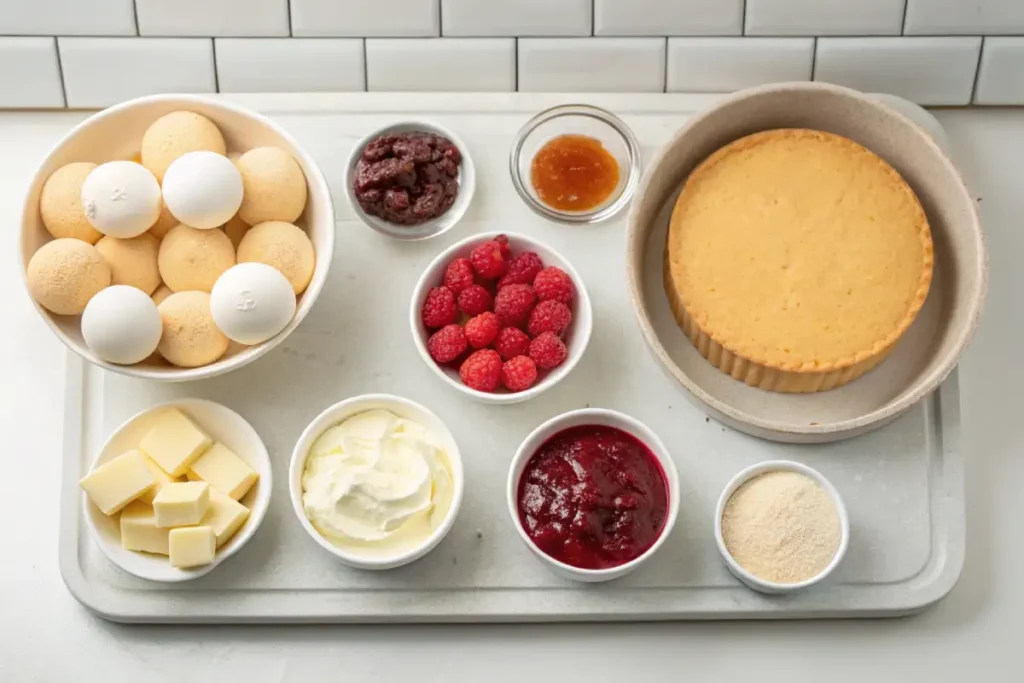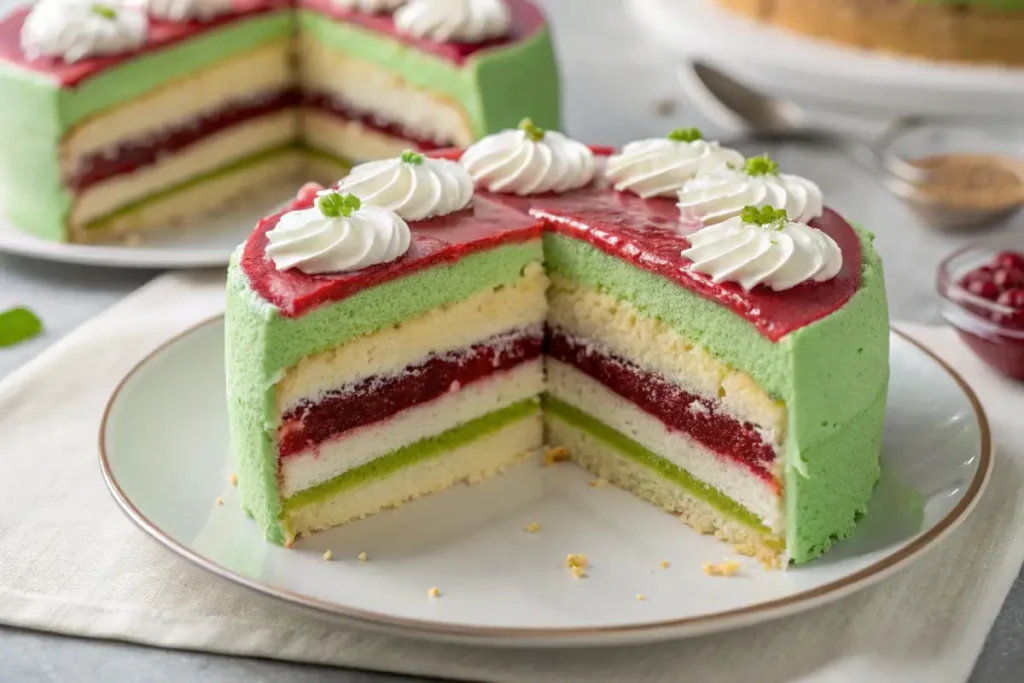Growing up, I had always been fascinated by desserts that had an aura of elegance. One day, I stumbled upon a Swedish classic – the Princess Cake, or Prinsesstårta. Its pastel green marzipan cover, the delicately placed rose, and its dome-shaped perfection captured my imagination. But it wasn’t just the look – the layers of sponge cake, raspberry jam, custard, and cream promised a flavor fit for royalty. Whether you’re a home baker or simply curious, this article will guide you through everything you need to know about Princess Cake – from its rich history to making your very own masterpiece.
Table of Contents
The History of Princess Cake
Origin and Name
The story of the Princess Cake begins in early 20th-century Sweden. Originally named Grön Tårta or “Green Cake,” this dessert was created by Jenny Åkerström, a culinary instructor to the Swedish princesses Margaretha, Märtha, and Astrid. These young royals adored the dessert so much that it was soon renamed Prinsesstårta – “Princess Cake” – in their honor.
Why It’s Called a Princess Cake
The connection between this dessert and Swedish royalty is more than just its name. The cake’s opulent yet delicate flavor, combined with its majestic appearance, made it a popular choice for royal celebrations and birthdays. Over time, the Princess Cake has become a symbol of Swedish heritage, enjoyed by people worldwide.
Cultural Significance
Princess Cake is traditionally served during festive occasions like birthdays, weddings, and graduations in Sweden. Its rich history and nostalgic charm make it more than just a dessert – it’s a celebration of Swedish culture.
What Makes a Princess Cake Unique?
Signature Layers
What sets the Princess Cake apart from other desserts is its unique combination of layers. At its core, the cake is built with alternating tiers of light sponge cake, rich pastry cream, and tart raspberry jam. These layers are then enveloped by a dome of freshly whipped cream, creating the iconic rounded shape. Finally, the cake is wrapped in a thin layer of pastel green marzipan, giving it its signature look.
Each bite is a delightful balance of textures – the softness of the sponge, the creaminess of the custard, and the slightly chewy marzipan. The subtle sweetness is perfectly offset by the tanginess of the raspberry jam, creating a harmonious flavor profile.
The Iconic Dome Shape
One of the most recognizable features of the Princess Cake is its dome-like structure. This unique shape is achieved by carefully piling and smoothing whipped cream over the sponge layers. The result is a dessert that not only tastes heavenly but also has an elegant, sculptural quality.
The marzipan covering is an art in itself – rolled out to perfection and draped gently over the cake, it gives the dessert a polished, royal finish. The pastel green color is often complemented by a single pink marzipan rose and a dusting of powdered sugar.
A Treat That Feels Royal
Unlike other cakes that rely heavily on frosting, the Princess Cake’s beauty lies in its simplicity and delicate layering. Every detail, from its perfectly smooth marzipan to its rich yet light filling, speaks of sophistication, making it a dessert truly worthy of its regal title.
Traditional vs. Modern Variations
Traditional Ingredients and Recipe
The classic Princess Cake, or Prinsesstårta, follows a time-honored recipe that has remained largely unchanged since its creation in the 1920s. The traditional version is made with three main components: soft sponge cake, rich pastry cream, and tart raspberry jam. These layers are topped with freshly whipped cream to create the iconic dome shape, which is then covered in green marzipan.
The finishing touch is a single pink marzipan rose placed delicately on top, along with a light dusting of powdered sugar. This original recipe has been a staple at Swedish celebrations, from birthdays to weddings, symbolizing elegance and indulgence.
Modern Twists and Flavors
As the Princess Cake grew in popularity, bakers around the world began putting their creative spins on the classic recipe. Here are a few modern variations:
- Chocolate Princess Cake: Replacing the traditional green marzipan with a chocolate-flavored marzipan for a richer taste.
- Vegan Princess Cake: Using plant-based substitutes like coconut cream, almond milk custard, and vegan-friendly marzipan for those with dietary preferences.
- Floral Variations: Infusing the whipped cream or marzipan with flavors like rosewater or lavender for a floral twist.
- Seasonal Themes: Some bakers create holiday-themed versions, such as red or white marzipan for Christmas or pastel pink for Valentine’s Day.
Innovative Presentations
In addition to new flavors, bakers have also experimented with presentation. Miniature Princess Cakes, served as individual portions, are growing in popularity for events like tea parties. Others swap the pastel green marzipan for bold colors or hand-painted designs, adding a personalized touch to the cake’s already elegant appearance.
Step-by-Step Recipe for Princess Cake
Ingredients List
Here’s everything you’ll need to make an authentic Princess Cake from scratch:
For the Sponge Cake:
- 4 large eggs
- 1 cup granulated sugar
- 1 cup all-purpose flour
- 1 tsp baking powder
For the Filling:
- 2 cups whole milk
- 4 large egg yolks
- 1/2 cup granulated sugar
- 3 tbsp cornstarch
- 1 tsp pure vanilla extract
For the Whipped Cream:
- 2 cups heavy cream
- 3 tbsp powdered sugar
For the Marzipan Covering:
- 14 oz marzipan
- Green food coloring
- Powdered sugar for rolling
Extras:
- 1/2 cup raspberry jam
- Pink marzipan for the rose garnish

Step-by-Step Instructions
1. Bake the Sponge Cake
- Preheat your oven to 350°F (175°C) and grease a 9-inch round cake pan.
- In a mixing bowl, whisk eggs and sugar until light and fluffy (about 5 minutes).
- Gradually fold in sifted flour and baking powder. Mix gently to maintain the airiness.
- Pour the batter into the pan and bake for 20-25 minutes or until a toothpick inserted comes out clean. Let it cool completely before slicing into three equal layers.
2. Make the Pastry Cream
- Heat milk in a saucepan until steaming but not boiling.
- In a separate bowl, whisk egg yolks, sugar, and cornstarch until smooth.
- Slowly pour the hot milk into the egg mixture, whisking constantly. Return the mixture to the saucepan and cook over low heat until thickened. Add vanilla extract and let it cool.
3. Assemble the Cake
- Place the first sponge layer on a cake board and spread a thin layer of raspberry jam. Add a layer of pastry cream.
- Repeat this process with the second layer. Place the third sponge on top and spread whipped cream over the dome-shaped structure.
4. Cover with Marzipan
- Knead marzipan with green food coloring until evenly colored. Roll it out into a thin sheet using powdered sugar to prevent sticking.
- Gently drape the marzipan over the cake and smooth it down with your hands, trimming any excess at the base.
5. Add the Finishing Touches
- Shape pink marzipan into a rose and place it on top of the cake. Lightly dust with powdered sugar for a royal finish.
Pro Tips for Beginners
- Chill the whipped cream and pastry cream before assembling the cake for easier handling.
- Use a cake turntable for smoother marzipan application.
- If marzipan cracks, patch it with a bit of water and smooth it out gently.
The Art of Decorating a Princess Cake
Marzipan Covering Techniques
Decorating a Princess Cake is as much an art as it is a science. The marzipan layer, with its smooth, pastel green finish, is the centerpiece of this dessert. Here’s how to get it right:
- Roll the Marzipan Properly
Begin by kneading your marzipan until it’s soft and pliable. Add green food coloring to achieve the signature shade. Roll the marzipan on a powdered-sugar-dusted surface until it’s about 1/8 inch thick and large enough to cover the entire cake. - Drape the Marzipan with Care
Using a rolling pin, lift the marzipan sheet and gently drape it over the cake. Start smoothing from the top of the dome and work your way down the sides, avoiding wrinkles. Trim off any excess marzipan at the base using a sharp knife or pizza cutter. - Fixing Imperfections
If any cracks or tears appear, dab a bit of water on the affected area and gently smooth it with your fingers.
Adding the Signature Rose
The pink marzipan rose is the iconic finishing touch for a Princess Cake. Here’s how to make one:
- Shape the Rose Petals
Roll a small ball of pink marzipan for the rose center. Flatten additional small marzipan pieces into petal shapes. Wrap the petals around the center ball, slightly overlapping them to create a blooming effect. - Position the Rose
Place the rose in the center of the cake. To make it even more elegant, you can add a few green marzipan leaves underneath the rose.
Additional Decorations
For a more festive look, you can:
- Lightly dust the marzipan with powdered sugar for a snowy effect.
- Pipe decorative whipped cream around the base or top of the cake.
- Add edible gold or silver accents for a luxurious finish.
By mastering these decorating techniques, your Princess Cake will not only taste divine but look like it belongs in a royal banquet!

Want more decorating inspiration? Don’t miss the ideas in our Fluffy Cloud Cake for a rich and indulgent finish.
Occasions to Serve a Princess Cake
Royal Celebrations
A Princess Cake isn’t just any dessert – it’s a centerpiece for special occasions. Traditionally, it has been served during grand celebrations like birthdays, weddings, and anniversaries. Its luxurious look and indulgent flavors make it the perfect choice for events that call for something extraordinary.
In Sweden, Prinsesstårta is often enjoyed during Princess Day, a celebration tied to its royal origins. Many Swedish families have also made it a tradition to serve this cake at graduations, christenings, and Christmas dinners, honoring its timeless appeal.
A Unique Wedding Cake Alternative
For couples looking for a more understated yet elegant wedding dessert, the Princess Cake offers a unique alternative to the towering, fondant-heavy cakes. Its light flavors and classic appearance are ideal for intimate weddings or smaller receptions. The marzipan’s pastel hues can also be customized to match the wedding’s theme.
Everyday Indulgence
While a Princess Cake is often associated with grandeur, it can also bring a touch of elegance to casual gatherings. Whether you’re hosting a tea party, book club, or family brunch, a slice of this royal dessert can transform an ordinary moment into something special.
It’s especially popular for Mother’s Day or Valentine’s Day, where its delicate rose and soft colors symbolize love and appreciation. Mini Princess Cakes, which are easier to serve and share, have become trendy for these smaller celebrations.
Cultural Exchange
In recent years, Princess Cakes have grown popular outside of Sweden, often appearing at international food fairs and cultural festivals. Sharing a Princess Cake with friends from different backgrounds can be a wonderful way to introduce them to Swedish culinary traditions.
Where to Buy or Order Princess Cake
Top Bakeries Offering Princess Cake
Finding a beautifully crafted Princess Cake is easier than ever, thanks to its worldwide popularity. Here are some top places to consider:
- Swedish Bakeries
Authentic Swedish bakeries are the best place to find traditional Prinsesstårta. Look for establishments like IKEA cafes, which often feature Swedish desserts, or local Scandinavian bakeries. - Specialty Cake Shops
Many specialty bakeries offer Princess Cakes, particularly in areas with a strong Nordic community. Shops like Fika in New York City or Scandic Pastry in Los Angeles are known for their authentic takes on Swedish classics. - Online Cake Delivery Services
If you can’t find a local bakery, several online services can deliver Princess Cakes right to your door. Websites like Goldbelly or Nordic Sweets often feature traditional Swedish desserts, including custom-made Princess Cakes.
Custom Ordering Options
For special events, you can personalize your Princess Cake by working directly with a baker. Options include:
- Color Customization: Adjusting the marzipan’s pastel green to match your event theme (e.g., pink for Valentine’s Day or blue for baby showers).
- Miniature Versions: Individual-sized Princess Cakes are perfect for party favors or dessert tables.
- Flavors and Fillings: Some bakeries allow you to customize fillings, like switching the raspberry jam for strawberry or adding chocolate layers.
DIY Princess Cake Kits
If you prefer to try your hand at making one, several online retailers sell DIY Princess Cake kits. These kits include pre-made marzipan, sponge cakes, and filling, making it easier to recreate this royal dessert at home.
Nutritional Information and Healthier Alternatives
Calories and Nutritional Breakdown
A traditional Princess Cake may look delicate, but it’s rich in flavor and calories. Here’s an approximate breakdown for one slice (1/12 of a 9-inch cake):
- Calories: ~350–400 kcal
- Fat: 20–25g
- Carbohydrates: 40–45g
- Protein: 4–6g
- Sugar: 30–35g
The marzipan layer, whipped cream, and pastry cream contribute significantly to the calorie count. While it’s a delightful treat, it’s best enjoyed in moderation, especially if you’re watching your sugar or fat intake.
Healthier Substitutions
For those looking to enjoy the Princess Cake without the guilt, here are some healthier alternatives and substitutions:
- Lower-Calorie Sponge Cake
Replace the traditional sponge cake with a lighter, oil-based cake or a sugar-free version using natural sweeteners like erythritol or stevia. - Reduced-Sugar Pastry Cream
Use unsweetened almond milk or low-fat milk for the custard base, and reduce the sugar content by half. You can also add a hint of vanilla extract or almond extract for extra flavor without additional calories. - Whipped Cream Alternatives
Swap heavy cream for Greek yogurt whipped with a small amount of honey. This not only reduces fat but also adds a slight tang that complements the sweetness of the cake. - Marzipan Modifications
Use a thinner layer of marzipan or opt for almond paste with less sugar. Alternatively, you can substitute marzipan with naturally colored fondant for a lighter topping.
Portion Control Ideas
- Try making mini Princess Cakes, where each portion is perfectly sized for one person. This helps control calorie intake while still enjoying a full dessert experience.
- Serve smaller slices alongside fresh berries to balance the sweetness and add a nutritional boost.
Frequently Asked Questions About Princess Cake
Why is it called a Princess Cake?
The Princess Cake, or Prinsesstårta, was named after the Swedish princesses Margaretha, Märtha, and Astrid. The cake’s creator, Jenny Åkerström, was their home economics teacher, and the dessert became a favorite of the young royals. Originally called “Green Cake” (Grön Tårta), it was renamed to honor the princesses’ love for it. Its regal appearance, with its pastel green marzipan dome and elegant rose garnish, also adds to its royal name.
What is Princess Cake flavor?
The flavor of a Princess Cake is a delightful combination of sweetness and tanginess. It features layers of light vanilla sponge cake, tart raspberry jam, rich and creamy custard, and fluffy whipped cream. These layers are wrapped in a thin, slightly nutty marzipan coating, typically flavored with almonds. The overall taste is light, balanced, and delicately sweet, making it a favorite for celebrations.
What is Princess Cake IKEA?
The Princess Cake at IKEA refers to a ready-made version of the traditional Swedish dessert sold in IKEA’s food markets and restaurants. As IKEA is known for its Swedish heritage, they offer this classic cake to give customers a taste of authentic Swedish cuisine. The IKEA version stays true to tradition, featuring the signature green marzipan, whipped cream, custard, and sponge layers, but it’s conveniently pre-made for easy enjoyment.
What does Princess Cake flavor taste like?
Princess Cake flavor is a harmonious blend of sweet and tangy elements. The light vanilla sponge and whipped cream bring an airy sweetness, while the raspberry jam adds a fruity tartness. The custard layer contributes a rich creaminess, and the almond-flavored marzipan gives it a subtly nutty and unique finish. Together, these flavors create a delicate, balanced, and unforgettable taste that feels both luxurious and comforting.
Conclusion: The Global Love for Princess Cake
Popularity Beyond Sweden
While the Princess Cake originated in Sweden, its appeal has transcended borders. Today, this elegant dessert is beloved worldwide, often appearing in Scandinavian bakeries and international patisseries. Its unique combination of flavors, along with its iconic marzipan dome, has made it a favorite among dessert enthusiasts.
In countries like the United States and the UK, the Princess Cake has gained a following at Nordic cultural festivals, specialty bakeries, and even on popular cooking shows. It’s not uncommon to see it served at international events, highlighting Sweden’s rich culinary traditions.
Adapting to Local Cultures
As the Princess Cake gained global recognition, bakers in different regions began experimenting with local ingredients and flavors. Some notable adaptations include:
- Japan: Incorporating matcha (green tea powder) into the sponge or marzipan for an earthy twist.
- France: Adding a layer of almond cream or substituting marzipan with pâte d’amande, a French almond paste.
- USA: Brightening the cake with bold marzipan colors and adding flavors like vanilla bean or salted caramel.
These creative takes honor the cake’s essence while adding a regional flair, making it accessible to diverse palates. To explore similar ideas, check out the Fruit in Black Forest Cake for another delightful treat.
A Symbol of Elegance
Whether enjoyed in its traditional form or a modern variation, the Princess Cake has become a symbol of sophistication. Its timeless design and royal connections make it a standout dessert for any celebration, big or small. No matter where in the world it’s served, the Princess Cake continues to enchant and delight.
